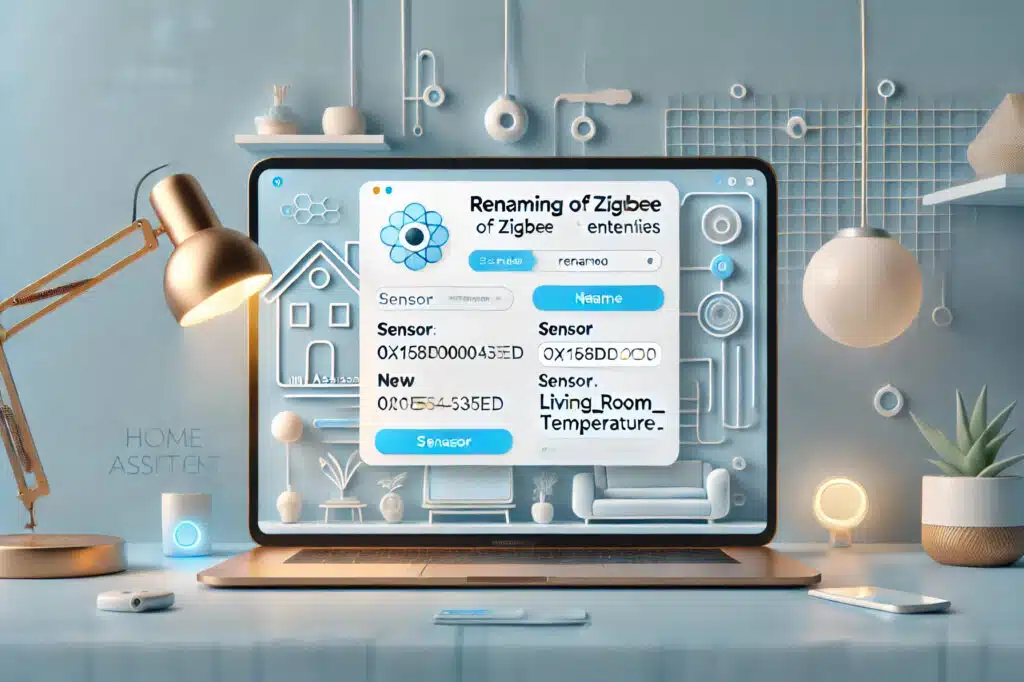
我在Home Assistant中,透過XiaomiGateway3來管理100個以上的Zigbee裝置。每一個Zigbee裝置都會有一個以_zigbee結尾的sensor實體,裡面有這個裝置關於zigbee通訊的資訊。新配對的Zigbee裝置在配對成功後,XiaomiGateway3會用它的IEEE 64位址(或稱MAC位址)來做所有實體的預設命名,但在XiaomiGateway3某個版本之後,_zigbee結尾的sensor實體會在某種狀況下回到預設值,目前原因不明。

如上所示,車庫門的磁簧感應器都以garage_door_contactsensor開頭,但_zigbee這個實體卻變回預設值0x00158d0(下略)。
如果沒有用到這個實體,其實也不是什麼太大的問題,但我會拿它來計算每一種感應器類型的數量,例如計算磁簧感應器的數量
- platform: template
sensors:
zigbee_contactsensor:
friendly_name: Zigbee_ContactSensor
value_template: >-
{% set ns = namespace(counter=0) %}
{% for entity in states.sensor %}
{% if "ContactSensor Zigbee" in entity.name %}
{% set ns.counter = ns.counter + 1 %}
{% endif %}
{% endfor %}
{{ ns.counter }}
以及超過180分鐘未更新的磁簧感應器數量,這樣可以得知有多少磁簧感應器可能已經失去連線,需要確認一下連線狀態。
- platform: template
sensors:
zigbee_contactsensor_timeout:
friendly_name: Zigbee_ContactSensor_Timeout
value_template: >-
{% set ns = namespace(counter=0) %}
{% for entity in states.sensor if "ContactSensor Zigbee" in entity.name %}
{% if as_timestamp(now()) - as_timestamp(entity.last_changed) > 180 * 60 %}
{% set ns.counter = ns.counter + 1 %}
{% endif %}
{% endfor %}
{{ ns.counter }}
但100個以上的_zigbee實體要改名字是一件很麻煩的事,不太可能手動一筆一筆去修改。Home Assistant的WebSocket則提供了這種功能。可以透過類型””config/entity_registry/update”來修改實體的ID,其做法是
- (第一次使用)申請一個永久權杖,在http://homeassistant.local:8123/profile/security最下方的「永久有效存取權杖」,點選「創建權杖」並將權杖代碼複製下來。
- 連接Home Assistant的WebSocket API,網址是ws://homeassistant.local:8123/api/websocket。
- 透過永久權杖做認證,取得WebSocket的權限。
- 透過類型”config/entity_registry/update”修改實體ID
可以透過python來做這件事
import json
import websocket
# 填入Home Assistant內網IP與永久權杖代碼
HOST = "192.168.1.10:8123"
TOKEN = "xxx"
# 要更改的實體ID與新的命名
old_entity_id = "sensor.0x00158d0....._zigbee"
new_entity_id = "sensor.garage_door_contactsensor_zigbee"
def rename_entity(old_entity_id, new_entity_id):
websocket_url = f'ws://{HOST}/api/websocket'
ws = websocket.WebSocket()
try:
ws.connect(websocket_url)
# 確認WebSocket連線
auth_req = ws.recv()
# 傳送認證請求
auth_msg = json.dumps({"type": "auth", "access_token": TOKEN})
ws.send(auth_msg)
# 確認認證結果
auth_result = ws.recv()
auth_result = json.loads(auth_result)
if auth_result["type"] != "auth_ok":
print("Authentication failed. Check your access token.")
return
# 更改實體ID
entity_registry_update_msg = json.dumps({
"id": 1,
"type": "config/entity_registry/update",
"entity_id": old_entity_id,
"new_entity_id": new_entity_id
})
ws.send(entity_registry_update_msg)
# 確認更新结果
update_result = ws.recv()
update_result = json.loads(update_result)
if update_result.get("success"):
print(f"Entity '{old_entity_id}' renamed to '{new_entity_id}' successfully!")
else:
error_message = update_result.get("error", {}).get("message", "Unknown error")
print(f"Failed to rename entity '{old_entity_id}': {error_message}")
except Exception as e:
print(f"An error occurred: {e}")
finally:
ws.close()
if __name__ == "__main__":
rename_entity(old_entity_id, new_entity_id)
執行後得到成功將sensor.0x00158d0….._zigbee重命名為sensor.garage_door_contactsensor_zigbee的提示
Entity 'sensor.0x00158d0....._zigbee' renamed to 'sensor.garage_door_contactsensor_zigbee' successfully!
如果要大量且有規則地修改以符合我前述的需求,讓_zigbee的實體ID重新命名為sensor.{Friendly name}_zigbee的話,我就得先將所有sensor.0x(任意字元)_zigbee的實體ID及其對應的Friendly Name全部找出來,再一個一個自動去做修改。找出符合的實體ID可以透過API及regex實作。整段程式碼如下
import requests
import json
import re
import websocket
# 填入Home Assistant內網IP與永久權杖代碼
HOST = "192.168.1.10:8123"
TOKEN = "xxx"
# API認證表頭
headers = {
'Authorization': f'Bearer {TOKEN}',
'Content-Type': 'application/json'
}
# 列出符合sensor.0x(任意字元)_zigbee的實體ID及其對應的Friendly Name,得到entity_data。
def list_entities():
api_endpoint = f'http://{HOST}/api/states'
response = requests.get(api_endpoint, headers=headers)
if response.status_code == 200:
data = json.loads(response.text)
entity_data = [(entity['attributes'].get('friendly_name', ''), entity['entity_id']) for entity in data]
entity_data = [(friendly_name, entity_id) for friendly_name, entity_id in entity_data if re.search(r'^sensor\.0x.[a-z0-9]+_zigbee$', entity_id)]
return entity_data
else:
print(f'Error: {response.status_code} - {response.text}')
return None
# 根據entity_data裡的entity_id與friendly name,依據規則建立新的entity_id並將表格合併。
def process_entities(entity_data):
rename_data = []
for friendly_name, entity_id in entity_data:
new_entity_id = re.sub(r'^sensor\.0x.[a-z0-9]+_zigbee$', 'sensor.' + friendly_name.lower().replace(" ", "_"), entity_id)
rename_data.append((friendly_name, entity_id, new_entity_id))
rename(rename_data)
# 透過WebSocket做重新命名的動作,命名前會有提示問句確認是否修改。
def rename(rename_data):
websocket_url = f'ws://{HOST}/api/websocket'
ws = websocket.WebSocket()
try:
ws.connect(websocket_url)
auth_req = ws.recv()
auth_msg = json.dumps({"type": "auth", "access_token": TOKEN})
ws.send(auth_msg)
auth_result = ws.recv()
auth_result = json.loads(auth_result)
if auth_result["type"] != "auth_ok":
print("Authentication failed. Check your access token.")
return
for index, (friendly_name, entity_id, new_entity_id) in enumerate(rename_data, start=1):
print(f"\nEntity ID: {entity_id}")
print(f"New Entity ID: {new_entity_id}")
confirm = input(f"Do you want to rename '{entity_id}' to '{new_entity_id}'? (y/n): ").strip().lower()
if confirm == 'y':
entity_registry_update_msg = json.dumps({
"id": index,
"type": "config/entity_registry/update",
"entity_id": entity_id,
"new_entity_id": new_entity_id
})
ws.send(entity_registry_update_msg)
update_result = ws.recv()
update_result = json.loads(update_result)
if update_result.get("success"):
print(f"Entity '{entity_id}' renamed to '{new_entity_id}' successfully!")
else:
error_message = update_result.get("error", {}).get("message", "Unknown error")
print(f"Failed to rename entity '{entity_id}': {error_message}")
else:
print(f"Skipping renaming of '{entity_id}'.")
except Exception as e:
print(f"An error occurred: {e}")
finally:
ws.close()
if __name__ == "__main__":
entity_data = list_entities()
if entity_data:
process_entities(entity_data)
else:
print("No entities found matching the search regex.")
執行當下我有46個sensor.0x(任意字元)_zigbee的實體要重新命名,執行前會詢問是否修改,若要放成自動化修改的話可以將提示相關的程式碼移除即可。以其中一個為例
Entity ID: sensor.0x00158d0....._zigbee
New Entity ID: sensor.livingroom_tv_plug_zigbee
Do you want to rename 'sensor.0x00158d0....._zigbee' to 'sensor.livingroom_tv_plug_zigbee'? (y/n): y
Entity 'sensor.0x00158d0....._zigbee' renamed to 'sensor.livingroom_tv_plug_zigbee' successfully!


